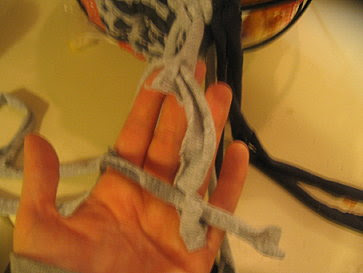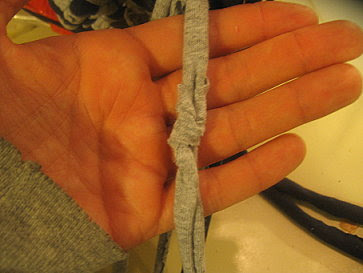In honor of our 1000th post in October 2014, we are counting down our most popular posts of all time. Each has received over 100K hits, and this one is well over 500K! This week, at #1, is Secrets of the No-Sew Rag Rug!
In honor of our 1000th post in October 2014, we are counting down our most popular posts of all time. Each has received over 100K hits, and this one is well over 500K! This week, at #1, is Secrets of the No-Sew Rag Rug!
 I thought that with all of the emphasis on recycling and reusing these days, a no-sew rag rug post would be more common. However, in my own internet research, I find that it’s something of a unicorn.
I thought that with all of the emphasis on recycling and reusing these days, a no-sew rag rug post would be more common. However, in my own internet research, I find that it’s something of a unicorn.
It follows the same principle that we all used in making those funny cotton loop potholders–under, over, under, over. See? You’ve already got 3/4ths of the technique.
No-Sew Homemade Rag Rug (Or trivet, potholder, centerpiece, place mat, what-have-you.)
1. Cut strips of fabric 1-3 inches wide and remove seams. I like three foot strips, but the length only matters for how often you want to be taking the time to join new strips.

2. Tie two strips in a simple loose knot. You’ll be trying to shove fabric through this later, so too tight and you might get aggravated. Also, notice that the pieces in the picture are UNEVEN. At the end of every strand, you’ll have to join a new one, and it looks better if that’s staggered.

3. If you want stripes like mine, arrange your strips so that they alternate A,B,A,B when you lay them flat. Then take the one on the right side and go under, over, under.
- Continue taking each right-hand strand and going under, over, under (Notice that it’s not a TIGHT braid. Just snug enough to lay flat and hold it’s shape.)

5. When you get a braid about 1/2 the length of the rug you want, it’s time to turn. I went under, over, under with that gray strip and then turned it to the right so I could tuck it in the edge of the original braid.
 Depending on your material, your rug may not want to lie flat if you turn it too quickly, so you may not get to tuck EVERY strand into the original braid. Sometimes you might have to skip tucking a couple so you can turn the corner smoothly.
Depending on your material, your rug may not want to lie flat if you turn it too quickly, so you may not get to tuck EVERY strand into the original braid. Sometimes you might have to skip tucking a couple so you can turn the corner smoothly.
6. Work your way back down to the starting knot following the exact same pattern as you used to make the original braid, just tucking the end through each time. (If you want the stripes, tuck it in it’s OWN color as you come around and down.)

7. Once you get back down to the original knot, and work your way around the curve, skipping and tucking as necessary to lay flat, it’s time to add a strip! To maintain the stripes, I joined one of each color together and stuck it through the starting knot in a way that kept the pattern. Then I continued braiding the same way I had been all along, but now it was under, over, under, over, under–>TUCK!
You can’t see, but there’s SIX strips now.
Important to keep an even number the whole way.
Intermission: WHEW, this is way harder to explain than it is to do! For another explanation, in fact the only other explanation I’ve seen on the whole internet, click here.
Let’s also pause to learn how to join (slip-knot) strips to each other:
Cut a hole in the ends of both strips you want to join. Shove the new on through the old one. Then push the tail end of the new strip through it’s own hole and tug until snug.



Back to our regularly scheduled tutorial…
8. Braid all of the way down to the end and back up the other side to the original knot. Add another strip where ever you can sneak it in to make eight strips.
 9. Pick up that right-hand gray one, and go under, over, under, over, under, over, under, over, under–>TUCK!
9. Pick up that right-hand gray one, and go under, over, under, over, under, over, under, over, under–>TUCK!

10. Every time you work yourself back to the beginning knot, add another set of strips until you get the size rug you’re looking for.
11. Once the rug is the width you want it across
the middle, it’s time to work yourself back down to 8 strips, then 6, 4, 2, and finally none in a way that doesn’t throw off your overall shape. When I decreased in the picture, I went under, over, under, over, under–>TUCK–>TUCK AGAIN under two more blues horizontally—>snip off the excess. Continue until you run out of strands.


Cool! What happened to the all time best #2? Did I miss it? 🙂
Claire–Good eye! Somehow it didn’t post as scheduled! We’ll try and see what happened there. Hm.
Hello Daisy,
I am wondering; is the picture of the rug at the top with the pink painted toenails a picture of the actual rug you made with the pattern described above? Or is that a different pattern?
Thank you,
Renee
Hi, yes, that is Deanna’s actual rug (and foot!)
So glad I found this! And thank you for making this tutorial… I’ve been wanting braided rugs for my home, had sticker shock at the prices to buy, and started looking for tutorials. I managed to find a 5 part series on you tube, but with a twist, she leaves yarn needles on the strips for the ‘poke-through’ step. I didn’t like she uses strictly stretchy t-shirt strips so the rug won’t curl. Am about to attempt my first rug, and alas I have no t-shirts to destroy (cleaned my closet when I moved) but I have denim galore and so am grateful to know ‘skipping tuck-ins’ is an alternate to curling rugs. And you’re right… Braid-in how-to instructions are rare!!!